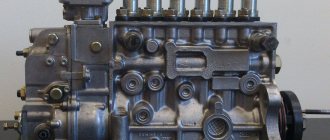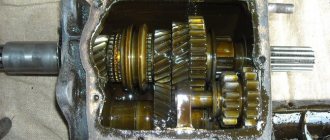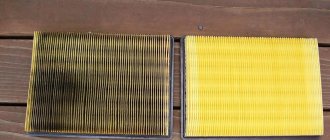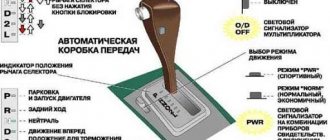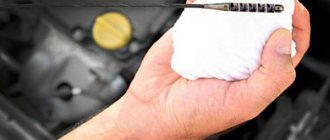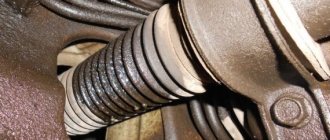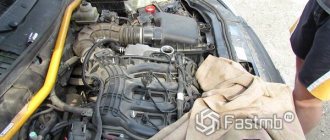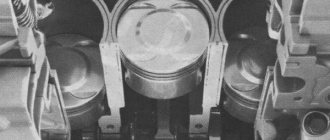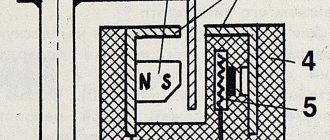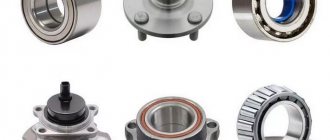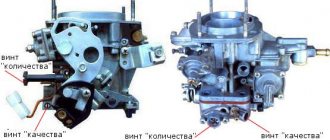Oil flows between the gearbox and the engine: why does this happen?
To better understand and quickly identify the problem, let's start with the features of lubricating fluids in gearboxes and internal combustion engines. The fact is that the operating conditions of the transmission and power unit are significantly different. For this reason, motor oil is poured into the engine, and special transmission oil is poured into the gearbox. For both the engine and the gearbox, the lubricant can have a mineral, synthetic or semi-synthetic base.
However, this is where the similarities end. Please note that these liquids differ greatly in their basic properties (viscosity) and chemical additive packages. This is due to the fact that in the engine lubricant is supplied to loaded components and parts under pressure, and to elements with lower loads it is supplied by splashing.
At the same time, the engine oil gets very hot, is subject to oxidative processes, etc. In most transmissions (except torque converter automatic transmissions), the mating parts are lubricated by splashing lubricant during rotation of the components; the load on the parts inside the transmission is much less compared to an internal combustion engine.
Such operating features also determine the overall service life of lubricants in each unit (on average, 10 thousand km for engine oil and 50-80 thousand for transmission oil). We also note that for each component, the vehicle manufacturer determines individual tolerances for viscosity and other lubricant parameters.
The viscosity of the engine or transmission oil is not suitable
Now let's get back to our main problem. It is quite obvious that if a leak between the gearbox and the engine appears immediately after switching from a “thicker” SAE oil to a low-viscosity lubricant (for example, mineral water was replaced with liquid synthetic), then there is a high probability of a banal discrepancy between the filled material and the recommended parameters.
To put it simply, the use of low-viscosity lubricants in gearboxes and internal combustion engines can lead to leaks. So what does this information give us? Most importantly, if the oil in the engine or gearbox turns out to be unsuitable, then leakage can be easily eliminated by replacing the lubricant with the recommended one.
If no other prerequisites for the occurrence of leaks have been identified, then it is appropriate to talk about a malfunction. In this case, analysis of the oil itself allows you to determine where it is flowing from, from the gearbox or engine. Let's take a closer look at this.
There is a malfunction in the internal combustion engine or gearbox: how to accurately determine
If the fluids poured into the engine and gearbox meet all the parameters, then an oil leak at the junction of the engine and gearbox is the result of a breakdown of one of these units. Less common, but quite possible, is the simultaneous occurrence of problems in both nodes at once.
As already mentioned, the lubricant in gearboxes and internal combustion engines differs in consistency, color and smell, which allows us to draw some conclusions. For primary diagnostics, this is very important, since it is possible to more accurately determine which unit is leaking and why. To do this, you need to carefully examine the streaks, color of the oil, dust and dirt on it.
Now let's move on to checking. Let us immediately note that limited access usually prevents us from accurately determining the cause. In other words, it may not be possible to visually inspect the junction of the engine and gearbox. In such a situation, the easiest way to determine where the fluid is coming from is
checking the engine oil level
.
To do this, the level is assessed using the dipstick; a decrease in the indicator will indicate problems with the motor. Let us add that the gearbox on some cars may also have its own oil dipstick. However, such a check allows you to accurately determine the problem unit when oil flows out intensively. In this case, you can usually also notice oil stains under the front of the car.
If only drips were found on surfaces and parts at the junction of the transmission and power unit, then the lubricant level does not always drop significantly. In such a situation, additional assessment of the leaking fluid helps.
Motor oil has a lighter reddish-amber hue, it is fluid, its smudges conditionally “absorb” dust and dirt. Transmission oil is usually darker and may have a reddish tint (ATF oil). This lubricant is thicker, has a characteristic pungent odor, smudges quickly become overgrown with a thick layer of dust, accumulating contaminants on its surface in the form of a “fur coat”.
Note that in practice the following method is also often used. Part of the leaking liquid must be collected in a container into which water has previously been poured. When motor oil enters water, it curls up, maintaining the shape of a drop, and then sinks down. The transmission fluid does not sink to the bottom, spreading across the surface in a spot.
What does the cap do and why does it leak?
By and large, the valve cover in any engine simply should not allow oil to splash while the engine is running, since in most cases it does not receive load from internal pressure. More precisely, it should not receive it.
Crankcase gases
In fact, the cause of an oil leak may be crankcase gases that create excess pressure above the gas distribution mechanism.
A leak from under the valve cover gasket is a problem for the Chevrolet Lacetti.
In the Chevrolet Lacetti, the crankcase ventilation valve is also responsible for the circulation of crankcase gases. If it is clogged, the pressure under the cap will increase, gases will begin to squeeze out the oil, and the first weak link in their path will be the gasket. In this case, the gasket, no matter how high-quality it is, will not last even five thousand miles. Therefore, if we notice oil leaking from under the Lacetti valve cover, it is worth unscrewing and checking the condition of the crankcase ventilation valve . This can be done in a few minutes with any aerosol carburetor cleaner.
Good and bad lids. Version two
As you know, the Chevy Lacetti has a plastic valve cover . Naturally, the engineers took this step in order to reduce the cost and lighten the engine. This affected the rigidity of the lid. In addition, plastic, even the best one, does not resist thermal deformation as actively as aluminum alloy. Once the engine is thoroughly overheated, the valve covers will begin to move, then there is no need to talk about tightness, the oil will penetrate under the gasket.
Plastic cover.
Aluminum cover.
We recommend: Diagnostics and repair of gasoline engine injectors
To check this version, remove the cover and install it on a flat steel plate (or on glass in extreme cases). If there is a gap of at least a millimeter between the stove and the lid, there is a chance that the gasket will leak . Planning the lid (drawing out the mating plane) is a waste of time, because the plastic is thin and by removing some of the material we will only make it worse, the lid will become even less rigid. The best solution in this situation is to replace the cover.
Version three: gaskets and rings
If we know for sure that the surface of the lid is perfectly flat, the vent valve is clean, but the gaskets are still leaking, the problem is most likely in the gaskets themselves. In addition, some people underestimate the role of the O-rings that are installed under the bolt heads. When replacing the gasket, it is imperative to change these rings. Branded GM seals harden very quickly and begin to leak oil, while rings from Kamaz that are almost the same size (they are white and cost an order of magnitude cheaper) can withstand high temperatures and completely retain elasticity for the entire service life of the gasket.
O-rings for bolts from Kamaz fit perfectly on the Lacetti
But gaskets also come in different quality. The frequency of replacement mainly depends on their quality. Some people prefer to use expensive German ones, while others prefer cheaper domestic ones, but having saved on gaskets, we often replace them. For example, a branded gasket GM96 353 002 costs about 450 rubles, but its service life does not please many . In addition, the material profile is simple square. The Parts Mall96 353 002 gasket performs a little better , but the Victor Reinz gasket with catalog number 155345601 . It has a T-shaped profile, and due to this there is a large area of overlap of the plane of the block head.
Valve cover gasket Victor Reinz.
Valve cover gasket GM 96353002.
Fourth version: bolts, sealants and hands
The gasket, even the highest quality one, must be installed with sealant. It must withstand high temperatures and not harm the catalyst. Many companies produce similar products in huge quantities, but sealant is different from sealant - only one that says “sensor-save” and “High-Temp” on the packaging is suitable for the valve cover . If the manufacturer has indicated these two important properties, then the composition of the sealant should already interest us. If applied correctly it will work great.
The 15 bolts that hold the valve cover to the head plane can stretch over time, causing the metal to fatigue and the threads to become loose. Therefore, many advise changing the bolts with each replacement . Moreover, when tightening, old bolts have a habit of breaking. One bolt costs about 20 rubles (cat. No. 94 500 909 ), which won’t hurt your pocket too much.
Cover mounting bolts.
Another important, if not the main point is gasket replacement technology . It is imperative that you thoroughly wash and clean the surfaces of the head and the lid from any remnants of old sealant, then degrease them, apply the sealant in a thin layer and be sure to let it harden exactly as long as indicated in the instructions.
When tightening bolts, it is highly recommended to use a torque wrench and follow the correct bolt tightening order.
Therefore, we draw conclusions. To prevent the valve cover gasket on the Lacetti from leaking for as long as possible, we control and pay attention to :
- Crankcase ventilation valve.
Ventilation valve.
- Valve cover seating plane.
- Gasket quality and profile.
The original gasket looks ridiculous compared to the Reinz.
- O-rings for fastening bolts.
O-rings.
- Use new bolts and sealant when replacing the gasket.
ABRO Black sealant.
- Using a torque wrench when tightening the cover bolts.
Torque wrench.
Of course, this is not a panacea, but if you follow these tips, your valve cover gasket will last much longer. Keep the under hood clean and smooth roads for everyone!
We recommend: Symptoms of a faulty coolant temperature sensor
Technical features of engine and gearbox lubrication systems
The design features of the engine and gearbox and their operating conditions determined the use of specific lubricants for each of these units. For technical reasons, it is impossible to fill the engine and gearbox with the same oil. For each unit, the use of liquids of different chemical compositions is provided.
The rubbing parts of internal combustion engines are lubricated thanks to a forced oil supply system to the right places. In gearboxes, mechanically contacting parts are enveloped in transmission fluid. This happens through self-spraying of oil by rotating parts.
The fluids used for the engine and gearbox differ in their chemical composition, viscosity level, additives used, and other technical characteristics. Various deadlines for replacing substances in these units have also been established. Engine oil is changed on average every 10,000–15,000 km. The transmission fluid of the gearbox retains the necessary performance much longer: it is changed after 60,000–90,000 km. Some manufacturers indicate that changing the oil in the gearbox is not provided until the end of the life of this unit.
Another important technological point should be taken into account. It is determined by what oils are used. It can be mineral water, semi-synthetic, synthetic. The service life and retention of astringent elasticity of such oils are not the same. In other words, each of them runs in its own way.
Therefore, situations are quite predictable when, when using mineral water, there was no oil leak between the engine and the gearbox, but after switching to another type of oil, it appeared. Practicing repairmen and experienced car enthusiasts tend to attribute such cases to different oil viscosities. Semi-synthetic and synthetic fluids have better fluidity compared to mineral water.
Let's sum it up
As you can see, drops of transmission oil under the car or obvious oiling of any areas with transmission fluid is a reason for a detailed inspection of the car. If there is no obvious suspicion that the gearbox housing has recently been damaged, then diagnostics are necessary.
Read more: UAZ Patriot 2021 model year in a new configuration body and prices photo video test drive reviews
First of all, you need to check the oil level in the gearbox to ensure it is not overfilled. At the same time, the performance and condition of the gearbox breather should be assessed in order to prevent transmission oil from being squeezed out due to an increase in pressure in the internal cavities of the box.
Finally, we note that when purchasing a new car or after repairing a gearbox with the replacement of individual elements, one should not exclude the possibility that a defective gearbox housing (with cracks) may be installed. Also, the oil seals, cuffs and seals themselves have defects and are often of poor quality.
Gears are difficult to engage or speeds on a manual transmission do not engage: the main causes of the malfunction and possible problems.
How to choose oil for a manual transmission. Changing the oil in a manual transmission, frequency and features of changing transmission oils in a manual transmission.
What causes a leak?
Practice shows that an oil leak at the junction of the engine and gearbox is a consequence of a malfunction of one of these units. Rarely, but there are still cases when leakage channels appear simultaneously in both nodes. A clear sign that lubricant is leaking out is oil stains under the front of the underbody of the car.
The first clue to determining where the oil is coming from is checking the lubricant level in the engine crankcase. If the dipstick shows a sharp drop in the oil level in the engine, then we can assume that the cause of the leak lies in engine malfunctions. The amount of lubricant lost will be indicated by the size of the oil stain.
The next step is to try to determine the quality of the leaking liquid. Engine and transmission oils differ in smell and consistency. The composition (degree of viscosity) and the aroma emitted will tell you what kind of fluid - engine or transmission - the car is losing. There is a simple way to determine. You need to place a piece of leaked lubricant in a container filled with water. The motor oil will curl into a drop and sink to the bottom. And a particle of transmission fluid will spread across the surface.
An accurate determination of the causes of lubricant leakage is hampered by limited access to inspect the areas between the engine and gearbox. Then you can take advantage of the results of operational practice and the advice of experienced drivers. Among the reasons that lead to oil leakage between the engine and gearbox are:
If the signs are accurately identified, the possible causes of leaks can be analyzed in detail. Then it is much easier to eliminate defects or causes of malfunctions. It is risky to take any action to eliminate an oil leak without determining where it is leaking from.
Symptoms of a problem
Before moving directly to the analysis of the reasons, it is worth understanding that oil leaks formed precisely between the internal combustion engine and the gearbox. The first direct sign is the appearance of an oily stain on the asphalt. Of course, an oil leak from the engine can come from anywhere. Therefore, it is worth diagnosing the malfunction in more detail.
To determine that oil is leaking from the engine, you must first remove the lubricant level dipstick from the engine and inspect where the oil mark is located. According to technical documentation, for almost all automakers, the lubricant level of the power unit should be located between the maximum and minimum marks, somewhere in the middle.
If the indicator has dropped significantly, then there are either oil leaks on the engine, or fluid is leaking between the engine and the gearbox.
To carry out a more accurate diagnosis, it is necessary to install the vehicle on a pit or lift and conduct an inspection from below. Since many vehicles have engine protection, it must be removed. After dismantling, it will immediately become clear where the oil goes from the engine. An oil stain will form between the gearbox and the engine and smudges will be visible.
Also, an indirect sign can be considered that oil stains were found under the car, and the clutch began to work hard, and gears are difficult to shift. It can be assumed that oil has squeezed out onto the disc and it is wet. This makes the transmission difficult to operate.
Possible causes of oil leakage between the gearbox and engine
first signs of an oil leak
first signs of an oil leak As soon as you notice the first signs of an oil leak, you must immediately look for the location of the breakdown. We cannot delay solving this problem. You don’t want to end up somewhere in the middle of a field and return home in a tow truck, do you? The most convenient way to determine the location of the oil leak between the gearbox and the engine is on a lift or pit. Drops of liquid are definitely a flaw and need to be gotten rid of.
It is unlikely that it will be possible to instantly identify a broken unit - the lack of direct access to vulnerable components makes this difficult task difficult. Most often, the problem is in the gearbox and, most likely, you will have to dismantle it to accurately diagnose and fix the problem.
Each car has its own characteristics, but there are some general principles for diagnosing and repairing breakdowns. First of all, you need to decide what type of oil is leaking - oil from the engine or from the gearbox? This can be determined by the smell and type of contamination. The size of the stain can determine the severity of the problem and the amount of oil lost.
In used cars, the main oil seal of the engine first begins to leak. Increased axial movement of the crankshaft causes the oil seal to be squeezed out and leakage occurs. Worn oil-resistant rubber of the oil seal can no longer hold back the oil, which has warmed up to a fluid state. When the crankcase ventilation system is clogged, the pressure in the system increases and excess oil escapes through weak points.
The transmission also has its own ventilation system: through a special breather, expanded hot air leaves the system. If it is clogged, excess pressure is created and the oil is also squeezed out. There is only one realistic option for eliminating oil seal leaks - replacement. And if you change one of the seals, it is better to immediately replace the second one, so as not to remove the box twice. You should immediately check the shaft play, the condition of its seat, and bearing wear.
What should you keep in mind?
Undesirable consequences can be caused by mixing fluids of different manufacturers and viscosity characteristics: if the oil leaks while driving, and there is nothing to top it up with, the car cannot be operated further. Call a tow truck and take the car to the nearest service station. Adding oil of a different composition - transmission or engine - is not allowed due to the fact that a destructive chemical reaction may begin inside the installation, which in turn will lead to even greater consequences. Of course, if a loss of fluid occurs on the highway, the driver can fill the system with oil at hand, but only to get to the specialists. In the future, the oil “compote” will have to be drained, and the installation into which it was poured will have to be thoroughly rinsed.
Source
Banal reasons
Why is oil leaking in the box? The reasons may be trivial.
This is a loose drain plug or unscrewed sensors. Sometimes a leak occurs due to a loose dipstick. Here, leakage points can be seen without dismantling the box and eliminated on site. But what to do if these parts are sealed, but oil still flows between the engine and the gearbox? Let's look further.
Causes of the problem and methods of elimination
Why is oil leaking? First of all, due to the loss of the sealant’s qualities. Thus, it is worth noting that lubricating fluid can leak not only from the engine, but also from the gearbox, which is even more dangerous, since on most cars it is impossible to determine the actual oil level in the transmission.
To fully ensure that oil is flowing between the engine and the gearbox, you should disassemble the already installed car in the pit. So, the engine protection is dismantled, and behind it the bolts connecting the gearbox and the internal combustion engine are unscrewed.
It is in the clutch housing pan that there will be a sufficient amount of oil, and the drive disc will be all wet.
So, the first thing that catches suspicion is the crankshaft oil seals. These elements can quite easily fail, even after 100 km, since it is impossible to immediately determine their quality. To fix the problem you will have to work hard, since in order to replace the crankshaft oil seal, it is often necessary to dismantle the pan.
Although, most motorists and engine repairmen do not do this. If we take into account cars such as the Volga, then instead of an oil seal, an oil seal packing is installed from which the lubricant will actually leak into the clutch housing.
Worn shafts and seals also become a fairly common cause of malfunction. This applies not only to the engine, but also to the gearbox. The first thing to come under suspicion is the input shaft, especially when it is an automatic transmission. In this case, it is necessary to replace the support bearings and inspect the housing for wear. If in this case everything is normal, then it is worth replacing the input shaft.
Also, the cause may be wear of the sealant that coats most joints of metal parts. If it is worn out, the oil can easily squeeze it out and a leak will form.
If the car is filled with inexpensive domestic motor oil, which does not have the best technical characteristics, then it will leak out easily, especially while the car is moving. Replacing the sealant can solve the problem of lubricant leakage, but to do this you will have to disconnect the parts where the leak occurred.
Perhaps one of the most common reasons why oil leaks between the engine and transmission is loosening of the connection bolts in the engine, namely between the pan and the cylinder block, where the crankshaft is attached. To eliminate the causes of the leak, it is worth tightening the bolts and inspecting the sealing joints.
If the block housing is worn out in the crankshaft bearing mounting location, in this case it is worth carrying out repair and restoration operations on the housing or selecting a bearing of a larger diameter.
In this case, it is worth considering that you will have to adjust the housing to the part; for this it will be necessary to make a groove for the seat of fastening and installation.
Eliminating oil leaks from under the valve covers
If leakage occurs due to a poor gasket, the defect can be eliminated quite simply - you need to change the sealing material between the valve body and the cylinder head. The valve covers are also easy to change, but here the car owner may encounter another difficulty - on some foreign cars the part can be expensive. There is an alternative option - buy a used spare part at a car dismantling site or through an advertisement.
When oil leaks due to poor crankcase ventilation, clogged passages should be cleaned. The ventilation system has a different design depending on the engine model; before you start cleaning, you should find out where these channels are located.
If oil is squeezed out from under the valve body due to a faulty piston group, this is the worst option. Here, cleaning the channels and replacing the gasket will not help; at a minimum, you will have to change the piston rings or carry out a major overhaul of the engine.
Eliminating oil leaks from the engine and gearbox
Some reasons leading to loss of transmission fluid from the gearbox can be eliminated without dismantling this unit. The following can be easily corrected:
A leak through the oil pressure sensor will require immediate replacement of the device. There is a rubber diaphragm inside the part. Its wear or loss of integrity causes a malfunction. The diaphragm may rupture. Then the engine lubricant is expelled through the sensor within a few minutes.
Some signs associated with a transmission fluid leak indicate that the transmission may need to be removed. This operation may be necessary if:
When eliminating the above reasons does not stop the flow of lubricant, you need to prepare for serious repair work. They can be expensive. Therefore, it is recommended to make at least a rough estimate. This procedure will help determine which option is more acceptable: serious repair of the box or its complete replacement.
Determining the leak area
Oil leaks are fairly easy to detect. Puddles of grease under the car will indicate a problem better than any diagnosis. The size of the puddles will help determine the extent of the problem. Whether to resort to the services of a car service or not is up to you, but it is imperative to park the car on the overpass. Otherwise, you will not be able to accurately detect the leak area.
For prevention, look under your own car more often. A puddle of oil shouldn't be an unpleasant surprise in the middle of a trip.
The transmission is not designed for manual repair. Its malfunctions are usually eliminated radically: by replacing it with another unit. This needs to be done in a garage, and not in the middle of the road.
An oil leak from the gearbox must be eliminated immediately after it is discovered. Delaying the resolution of this issue leads to increased wear of spare parts and deterioration of the condition of the unit.
Reasons requiring removal of the box from the car:
- violation of the tightness of gaskets or seals;
- wear of the main oil seal;
- wear of the gearbox input shaft oil seal;
- incorrect installation of seals;
- violation of the pallet geometry - a struck or bent pallet tears the gasket;
- a clogged crankcase ventilation system can create excess pressure and squeeze out oil;
- wear of the shafts that connect the engine and gearbox;
- gearbox input shaft play;
- breakdown of the torque converter or oil supply pump on automatic transmissions.
Consequences of untimely repairs
Why oil leaves the engine and where it is determined. Now it’s worth considering the consequences of untimely repairs. As you know, an engine without oil cannot move, since oil not only has lubricating properties, but also has cooling properties. Therefore, the consequences of a low oil level in the engine will be fatal, especially during long-term operation of the power unit. Let's consider the main consequences:
- Increased wear on the crankshaft and piston group. Thus, an insufficient oil level can lead to significantly higher production.
- Increased wear of parts will lead to the appearance of a large amount of metal shavings in the remaining lubricant, which will further increase the degree of wear of parts. Thus, the oil seals and sealing elements are the first to wear out.
- Also, a low oil level, both in the box and in the engine, leads to the engine overheating greatly, and accordingly there is a possibility that the engine will overheat and the cylinder head will become deformed or deflected.
Why does car oil leak?
- Problems with seals. High pressure in the transmission constantly affects the seals, changing their condition. Wear of the oil seal leads to the appearance of a gap through which oil fluid leaks out of the automatic transmission/manual transmission. It is possible to get rid of gearbox oil leaks by replacing the oil seal. It is recommended to find out the cause of the increased compression and eliminate it.
- The input transmission shaft is subject to wear and backlash is formed. The gearbox needs to be dismantled and we need to think about how to fix the leak. Change the shaft, install a new lining. It all depends on the size of the backlash.
- Check all connection areas along the direction of the oil movement. Leaks can be detected by stains of lubricant. Replace the sealing element.
- Check that the cover of the hole through which the oil drains into the automatic transmission is tightly screwed on. Correct the special probe.
- A clogged breather can lead to increased compression in the unit. Having discovered this fact, dismantle the gearbox and clean the breather.
The breather must be clean
This list of probable causes of oil leakage is incomplete. Only the most common reasons are listed here.
Front
It is much easier to change than the rear one. The element is located at the end of the crankshaft (on cars with a transverse engine - near the right pillar). To replace, we need to remove the timing belt cover and place the piston of the first cylinder at TDC. We loosen the tensioners and remove the timing belt from the outside, as well as the generator, having first removed the pulley. Drain the engine oil. Remove the crankshaft pulley. Unscrew the oil pump. An oil seal will be pressed inside it. You can remove it using a minus screwdriver. The new one is pressed in using a large head (27 and above) or on a special machine. Further assembly is in reverse order.
How to change the rear oil seal?
This procedure is quite complicated, since the element is located behind the clutch system. If it is a rear-wheel drive car, the driveshaft is removed. Next, as on front-wheel drive vehicles, there is a gearbox, a clutch assembly with a basket and discs, as well as an engine flywheel. The rear oil seal itself is installed in the housing and secured with eight bolts.
After unscrewing them, take out the housing and press in a new element. If you have difficulty installing it, you can use a rubber hammer or a regular steel hammer using a soft spacer. The latter can be made from a piece of an old car camera. Next, all the elements are assembled in reverse order.
Do oils and additives eliminate noise in the gearbox?
Practice proves that noise in the operation of the gearbox appears as the car moves, both at speed and in neutral gear. In this case, the nature of the noise will be fundamentally different. But in any case, the presence of noise indicates a malfunction of the gearbox, which can lead to lubricant leakage.
A hum in the gearbox while driving in neutral is associated with damage to the drive shaft bearing or a low level of transmission fluid. The failure of the synchronizer clutch or blocking component is indicated by noise that appears while driving in a certain gear. This often happens at speed 3 and above. Extraneous noise is caused by a loose gearbox. Incomplete pressing of the clutch pedal also provokes the appearance of noise or grinding noise in the gearbox. These problems lead to lubricating fluid running between the engine and gearbox.
Added additives, which contain special substances to restore the elasticity of seals, help prevent oil leaks for a short time and eliminate noise. This ensures the restoration of tight contacts between the oil seals and shafts. If the oil leaks insignificantly, it may stop for a while. However, the wear of parts is not preserved, and serious damage is not repaired.
Additives can have a negative effect on vehicle components. High-quality oils initially contain additives in balanced proportions. Adding new components violates the established relationships. The transmission fluid will lose some of its functional properties. But that's not so bad. Adding an additive leads to clogging of the engine or gearbox lubrication systems. Therefore, it is better to abandon dubious experiments and use exclusively transmission fluid that is recommended by the car manufacturer. And you will have to refrain from using additives in order to avoid serious technical consequences.
Experienced technicians and car owners do not recommend using oil thickeners. These substances can stop flowing. But at the same time, lubrication of mechanical components deteriorates and wear on engine or gearbox parts increases. In extreme cases, the use of a softening sealant is allowed.
Fixing an oil leak should not be delayed. A drop in the lubricant level in the engine or gearbox leads to serious damage to these units. The released lubricant contaminates other functionally important parts and components.
Tips and tricks
The appearance of malfunctions or noises clearly indicates both breakdowns and problems with the lubricant (insufficient or high level, loss of properties, non-compliance of the lubricant with tolerances and requirements, etc.).
For example, if the box hums in neutral, then the bearing on the drive shaft may fail or the transmission oil level may be low. If the problems are related to the synchronizer clutch or blocking element, then noise in the box appears when driving in a certain gear (usually in high gear, 3rd speed, 4th, etc.).
A hum from the box may also appear when the gearbox is loosened. Insufficient clutch pedal pressure or problems with this unit (especially on cars with a single-disc “robot” manual transmission) cause crunching, jerking, jolting, and difficult shifting. In this case, the parts experience increased loads, after which defects arise, and oil appears at the junction of the box and the engine.
If the situation is emergency, that is, a lubricant leak appears on the road and there is no way to send the car for repairs, then many drivers try to stop the leak with the help of special additives. As a rule, softening sealants of the “stop-leak” type contain components that allow the elasticity of the sealing elements to be restored.
In other words, it is possible to restore the tightness between the shafts and seals for some time. This allows you to get to the vehicle repair site on your own. So, we strongly do not recommend using such solutions both in the engine and in the gearbox.
First of all, the additive does not remove wear on parts, that is, the damage itself not only persists, but also progresses. Also, this method is not suitable for strong leaks. Moreover, the additive has a serious impact on the lubricant and on the parts themselves inside the assembly. Otherwise, adding an additive worsens the basic properties of the engine or transmission oil and clogs the engine and gearbox lubrication system.
A frequent result is that after disassembling the unit into which such additives were previously poured, it is discovered that it is completely unrepairable or there is significant wear not only on the initially problematic ones, but also on other structural elements.
For this reason, it is better to choose the right lubricant for topping up and use it as needed than to buy sealants and additives. Also, auto mechanics and experienced drivers do not recommend switching to a thicker lubricant after detecting leaks, which is not recommended by the vehicle manufacturer or does not meet the operating conditions of the vehicle.
The same can be said about special oil thickeners. Although this approach in some cases makes it possible to reduce or eliminate leaks, the lubrication of associated loaded parts also deteriorates. As a result, the wear of engine or gearbox parts greatly increases.
About the selection of oil seals for gearboxes
When purchasing, you need to consider what kind of oil you will pour into the box in the future.
There are oil seals with different elasticity - for mineral and synthetic products. If you pour inappropriate oil into the box, such an element will begin to crack. This usually happens with “synthetics”. It has good flushing properties. Note that for automatic transmissions there is a separate range of oils with a certain viscosity. Their properties differ significantly from manual transmission fluids.
